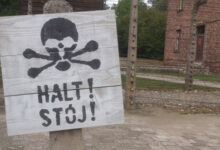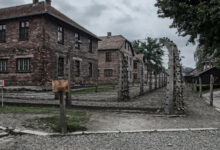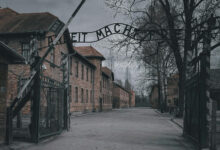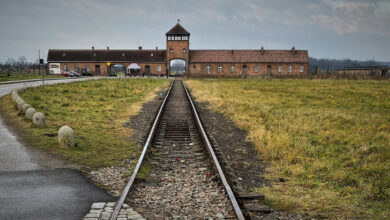Auschwitz, located near the town of Oswiecim in southern Poland, was the largest concentration and extermination camp established by Nazi Germany during World War II. Comprised of three separate camps – a prison camp, an extermination camp, and a slave-labour camp. Auschwitz played a horrifying role in the Holocaust. Between 1.1 and 1.5 million people tragically lost their lives there, with 90 percent of them being Jews.
The camp was first established in April 1940, initially serving as a quarantine camp for Polish political prisoners. However, its sinister purpose intensified in June 1941, when Hitler invaded the Soviet Union in an attempt to secure additional territory. The first gassing at Auschwitz, involving a group of Soviet prisoners of war, occurred around August 1941.

Auschwitz’s brutal history is marked by shocking events and facts that serve as crucial reminders of the atrocities committed during the Holocaust. Subcamps such as Birkenau, also known as Auschwitz II, expanded the complex and further contributed to the massive scale of suffering. As you delve into the chilling realities of Auschwitz, it’s an opportunity to broaden your understanding of history and to learn from past mistakes to make the world a better place.
Auschwitz concentration camp Origins and Construction
During World War II, Nazi Germany established Auschwitz, which would become the largest and deadliest camp in their concentration and death camp system. The camp was situated in and around the small town of Oswiecim, Poland, about 37 miles west of Krakow. The complex was made up of three main camps and 45 smaller sub-camps.

In 1939, after Germany annexed Poland, the idea for Auschwitz was conceived as a concentration camp, primarily to serve as a detention centre for the numerous Polish citizens arrested during this period. Heinrich Himmler, a leading member of the Nazi Party and the main architect of the Holocaust, ordered the establishment of the camp in April 1940. Rudolf Höss, a high-ranking SS officer, was appointed as the first commandant of Auschwitz.
The construction of the camp began with Auschwitz I, which was primarily used for holding prisoners and hosting forced labour. In early 1942, the first gas chamber and crematorium began operating, followed by a second one later in the year. By mid-1942, construction commenced for Auschwitz II-Birkenau, which included four large gas chambers and crematoria that were designed to kill and burn an estimated 1.6 million people per year.
Auschwitz III-Monowitz, another significant part of the complex, was established as a labour camp for the nearby Buna synthetic rubber and chemical plant. The construction of this plant began in mid-April 1941, with the first prisoner labour detail arriving at the site to work on the project.

Auschwitz I
Auschwitz I, located near the town of Oświęcim in southern Poland, has a dark history as one of the most infamous Nazi concentration camps established during World War II. This camp, originally built to detain political prisoners, first started receiving inmates in May 1940.
As a prisoner entering Auschwitz I, you would have been one of the many subjected to forced labour under the watchful eye of the SS garrison administration. The camp’s commandant and the local garrison commander oversaw these operations. In August 1944, among the camp’s rough estimate of 16,000 prisoners, about 10,000 were Jews, 4,000 were ethnic Poles, and 3,000 belonged to other ethnic groups.
The living conditions in Auschwitz I were appalling. The barracks, initially designed for the Polish army, were repurposed to accommodate the influx of prisoners. Overcrowding was a significant issue, with multiple inmates sharing a single bunk. The lack of proper sanitation led to rampant diseases and high mortality rates.

The camp was also a site of mass extermination. Inside Auschwitz I stood the notorious gas chambers where countless lives were extinguished. In addition to the gas chambers, you might have witnessed other forms of cruel punishment and suffering, including hanging, shooting, and various brutal medical experiments performed on the prisoners.
As an inmate in Auschwitz I, you would have experienced unimaginable horrors and brutal treatment under the ruthless Nazi regime. The atrocities committed there continue to serve as a stark reminder of the inhumanity and monstrosities that took place during the Holocaust.
Auschwitz II-Birkenau
Auschwitz II-Birkenau was the largest of the over 40 camps and sub-camps that made up the Auschwitz complex. Construction of the camp began in October 1941 at Brzezinka, near the town of Oswiecim in Poland. The camp had various functions during its three years of operation. Initially intended to house 125,000 prisoners of war, its primary role later became that of an extermination camp for the European Jews.
At Auschwitz II-Birkenau, the Nazis implemented their “Final Solution,” aiming to systematically eradicate the Jewish population. The camp had a total capacity of ten sections, each separated by electrified barbed-wire fences. SS guards patrolled the area, ensuring the camp’s operation ran smoothly. Among its several functions, Auschwitz II-Birkenau also served as an extermination camp and a slave-labour camp.
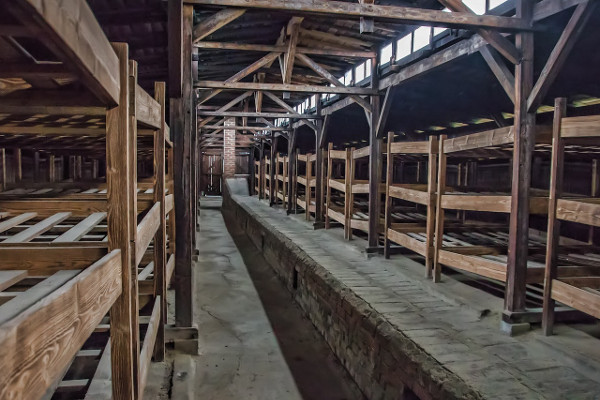
The death toll at Auschwitz II-Birkenau was staggering, with an estimated 1.1 to 1.5 million people perishing in the camp. Approximately 90% of the victims were Jews. The Nazis used various methods for extermination, the most notorious being gas chambers.
These chambers, filled with poisonous Zyklon-B gas, claimed countless lives in a cruel, systematic manner. After the victims were murdered, their corpses were removed by young Jewish males, known as “Sonderkommando,” who were responsible for clearing the gas chambers and crematoriums.
Although Auschwitz II-Birkenau was the site of unimaginable suffering and death, the prisoners still managed to show remarkable resilience. In October 1944, a group of Sonderkommando staged a revolt, attacking their guards and demonstrating an unbreakable spirit of resistance in the face of overwhelming odds.

Auschwitz III and Subcamps
Auschwitz III, also known as Monowitz, was one of the largest subcamps of Auschwitz. It was primarily associated with the IG Farben factory, which used the prisoners as forced labour. Monowitz held around 12,000 prisoners, and the majority of them were Jews, in addition to non-Jewish criminals and political prisoners.
The SS charged IG Farben three Reichsmarks (RM) per day for unskilled workers, four (RM) per hour for skilled workers, and one and one-half (RM) for children.
During its operation, Auschwitz had several subcamps under its jurisdiction. In November 1944, Auschwitz I and Birkenau were placed back under one command, and Auschwitz III was named Monowitz. The commandants of Auschwitz I were Rudolf Höss (May 1940 – November 1943), Arthur Liebehenschel from (November 1943 – May 1944), and Richard Baer (May 1944 – 27 January 1945).
Auschwitz is infamous for the “Arbeit Macht Frei” sign, which translates to “work sets you free,” displayed at the main entrance of the camp.
Despite its message, it hid the painful truth of the prisoners’ reality, where they were subject to inhumane conditions, forced labour, and ultimately death. You can learn more about the meaning and history of the Auschwitz gate from this article and explore the camp’s role in the Holocaust.
Inhumane Experiments
During the Holocaust, numerous reprehensible medical experiments were conducted at Auschwitz concentration camp, with many of them led by the infamous Dr. Josef Mengele. As a visitor to the camp, you would witness heinous acts carried out in the name of Nazi racial ideology and eugenics.
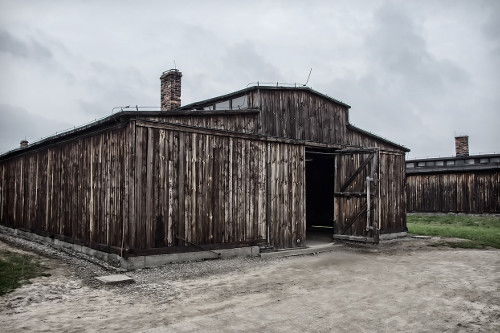
Mengele’s experiments focused on two main groups – Jews and Roma (“Gypsies”). In several cases, these experiments were lethal by design, whilst others led to the deaths of the subjects due to the extreme conditions imposed upon them.
You might be horrified to know that Mengele’s work often involved genetic tests, as he sought to validate Nazi racial theory and justify the persecution of these minority groups.
One of the chilling procedures carried out by Mengele at Auschwitz was the sterilisation of individuals to ensure their genes could not be passed on. This was achieved through various methods, including surgery, radiation and chemical injections. The primary aim of these ghastly experiments was to prevent the procreation of those deemed “racially inferior” by the Nazi regime.
In addition to Mengele, other physicians conducted inhumane experiments at Auschwitz and other camps. These studies were intended to benefit German military personnel in combat situations, develop new weapons, and aid in the recovery of injured soldiers.
Among these abhorrent tests were the seawater survival experiment, where 90 individuals were deprived of food and forced to endure drinking only seawater for six to twelve days. Most subjects were left with severe injuries from dehydration and starvation.
Read also:
- Auschwitz Dress Code
- Auschwitz Tour Price
- Auschwitz Tours from Krakow
- Can You Eat at Auschwitz?
- Can You Take Photos at Auschwitz?
- How Old Do You Have to Be to Visit Auschwitz?
- How to Visit Auschwitz
- Tickets to Auschwitz
- What Do I Need to Know Before Going to Auschwitz?
- What to Expect During Your Visit to Auschwitz
- What not to do at Auschwitz
Prisoners and Victims
At Auschwitz, a variety of prisoners were held, including Jews, Roma, Poles, and others. Among these prisoners, a significant number were children, with thousands of lives tragically lost during their time in the camp.
During their admission procedure at Auschwitz, prisoners underwent a dehumanising process where their entire body hair was cut and shaved for alleged hygienic reasons. This grim procedure can be exemplified through the Auschwitz room of hair, a chilling reminder of the suffering experienced.
In addition to the Jews, other groups like the Roma and Poles faced unbearable living conditions in the camp, forced into manual labour and subjected to constant abuse from the SS guards. Executions were a common occurrence; at the notorious “Black Wall” in Block 11, thousands of prisoners met their untimely end.

Auschwitz-Birkenau was a killing centre where approximately 1,095,000 Jews were deported and 960,000 died. This death toll included gypsies, children, and members of various other ethnic groups. It is paramount to remember the scale of victims during those unimaginable times and honour their memories.
The stories and remnants from Auschwitz serve as a chilling testament to the dark side of humanity. The belongings left behind, such as the piles of Auschwitz shoes, are stark reminders of the brutal violence inflicted upon innocent lives during the Holocaust.
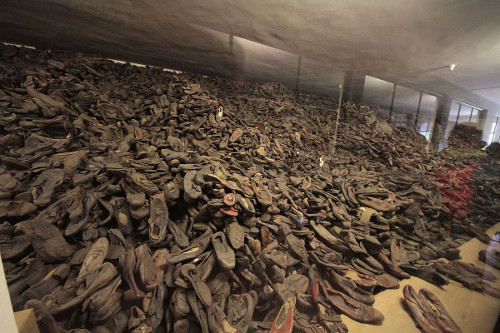
Survival and Resistance
Auschwitz, a complex of Nazi concentration and extermination camps, was a horrifying testament to the cruelty of World War II. Amidst the darkness, however, there were stories of survival and resistance that still resonate. Survivors and escapees played a crucial role in exposing the atrocities occurring in the camp, often at great personal risk.
One of the first successful escapes from Auschwitz was carried out by Tadeusz Wiejowski, a Polish political prisoner. In July 1940, he managed to flee from the camp along with a few other prisoners. Their daring act boosted morale among the remaining prisoners and provided vital information about the camp to the outside world.
Another remarkable escape took place in June 1942, when Kazimierz Piechowski, a Polish Boy Scout, fled Auschwitz with three other prisoners. They not only stole SS uniforms and a car but also forced a locksmith to make a copy of the main gate key. Thanks to their cunning plan, they successfully drove out of the camp, right under the noses of the guards.
Witold Pilecki, a Polish resistance fighter, went a step further by voluntarily entering Auschwitz. He smuggled himself into the camp in 1940 and spent nearly three years gathering intelligence and forming a resistance network. In April 1943, Pilecki managed to escape, and his report to the Polish government-in-exile and the Western Allies provided some of the earliest detailed accounts of the Holocaust.
Resistance within Auschwitz also extended to the Sonderkommando, a group of prisoners tasked with the harrowing job of disposing of the corpses from gas chambers and crematoriums. In October 1944, they staged a revolt, destroying one of the crematoriums and killing several SS guards.
Although the uprising was ultimately suppressed, it revealed the prisoners’ unyielding determination to resist their oppressors.
If you’re interested in learning more about Auschwitz, consider taking one of these tours:
Liberation and Aftermath
In January 1945, the Soviet troops approached Auschwitz. As the liberating forces closed in, your knowledge of the events that transpired becomes crucial to understanding the aftermath.
Upon arrival, the Soviet Army found over 7,000 surviving prisoners, most of whom were weak, malnourished, and suffering from illness. In addition to the survivors, they discovered thousands of corpses, as well as personal belongings of the victims.
The Soviet soldiers played a vital role in documenting the atrocities they witnessed, thus providing crucial evidence for future war crime prosecutions. The liberation of Auschwitz led to the establishment of 27 January as International Holocaust Remembrance Day.
In the months following the liberation, many Jewish survivors hesitated to return to their former homes, primarily due to the lingering antisemitism and the psychological trauma they endured. Fear for their lives persisted, as is evident from the violent anti-Jewish riots that occurred in post-war Poland.
Given these critical facts, it is evident that the liberation of Auschwitz by Soviet troops marked a turning point in history. This event exposed the horrifying reality of the Holocaust and contributed significantly to the establishment of legal and moral frameworks to prevent such atrocities in the future.
Recognition and Remembrance
Auschwitz plays a central role in Holocaust remembrance due to its sheer scale and the horrifying events that took place there. In 1942-1944, it became the largest Nazi killing centre, with approximately 1.3 million people deported to the camp. Today, the Auschwitz-Birkenau complex serves as a museum, a memorial and a UNESCO World Heritage Site, commemorating the victims of the Holocaust.
Holocaust Memorial Day is observed annually on January 27, marking the liberation of Auschwitz by Russian troops in 1945. On this day, the world remembers the Holocaust, honouring the memory of six million Jews and millions of other victims killed by the Nazis and their collaborators. In 2020, more than 200 Auschwitz and Holocaust survivors gathered at the former Auschwitz II-Birkenau camp to commemorate the 75th anniversary of its liberation.
If you are planning to visit the Auschwitz-Birkenau Memorial, it’s essential to be aware of Tickets to Auschwitz and various options to ensure a smooth and meaningful experience. The memorial is located near Krakow, Poland, and can be visited through guided tours, which enable you to gain a deeper understanding of the camp’s history and the events that unfolded there.
Apart from the Auschwitz-Birkenau complex itself, there are numerous Holocaust education and remembrance activities organised worldwide by the United Nations and various institutions, ensuring that the lessons of the past are not forgotten and that we continue working together to build a future based on understanding, tolerance, and respect.
Frequently Asked Questions
What was the purpose of Auschwitz-Birkenau?
Auschwitz-Birkenau was a complex of concentration, forced labor, and extermination camps built and operated by Nazi Germany during World War II. The main purpose of Auschwitz-Birkenau was to imprison and systematically murder Jews, as well as other groups considered undesirable by the Nazi regime, such as Romani people, homosexuals, political dissidents, and disabled individuals.
How many people perished at Auschwitz?
It is estimated that around 1.1 million people were killed at Auschwitz, the vast majority of whom were Jews. Other victims included Romani people, Soviet prisoners of war, disabled individuals, homosexuals, and political dissidents.
What were the living conditions like for prisoners?
The living conditions at Auschwitz were incredibly harsh and inhumane. Prisoners were housed in cramped, unsanitary barracks with little to no bedding or personal belongings. They were given meager rations of food and water, and were subjected to forced labor for long hours each day. Disease, malnutrition, and physical abuse were rampant, and prisoners were often subjected to brutal punishments for even minor infractions.
What role did Dr. Josef Mengele play at Auschwitz?
Dr. Josef Mengele was a physician who served as a medical officer at Auschwitz. He conducted horrific medical experiments on prisoners, particularly on twins and other individuals with genetic abnormalities. Mengele was known for his sadistic behavior and his willingness to inflict pain and suffering on his subjects.
Start Planning Your Krakow Trip Now!
- Unsure where to stay in Krakow? Discover top-rated Old Town and Kazimierz hotels with Booking.com.
- Book your airport transfer now and enjoy a hassle-free ride directly to your hotel. Driver will meet you at John Paul II International Airport Kraków–Balice.
- Take a Tour of Auschwitz. Arrange a visit to the Auschwitz-Birkenau Memorial and Museum to pay tribute and learn about this significant historical site.
⚠️ SUMMER BOOKING ALERT: Auschwitz tours are in high demand during the busy summer season. Secure your visit now to guarantee your preferred date and time slot. Last-minute availability cannot be guaranteed during this peak season. Due to increased visitor numbers in summer, it’s strongly recommended to book your tickets and tour to Auschwitz well in advance to secure your preferred dates and times! 🔖
- Explore the Fascinating Wieliczka Salt Mine! Book your guided tour today. These tours are very popular, so book early to avoid disappointment and ensure your spot.
- Looking for ideas? Check out our KrakowTOP.org recommended itineraries, including the famous Christmas Market, holiday events, and must-see Krakow attractions like Wawel Castle, Oskar Schindler’s Factory and St. Mary’s Basilica.
How was Auschwitz liberated?
Auschwitz was liberated by Soviet forces on January 27, 1945. By this time, the Nazis had already evacuated many of the prisoners on death marches, and the remaining inmates were in a state of extreme malnutrition and illness. The liberation of Auschwitz marked the end of one of the most horrific chapters in human history.
What are some notable films or books about Auschwitz?
There have been many films and books about Auschwitz, some of which include “Schindler’s List” by Thomas Keneally, “Night” by Elie Wiesel, “The Pianist” by Władysław Szpilman, and “The Boy in the Striped Pajamas” by John Boyne. These works provide important insights into the experiences of those who suffered and died at Auschwitz, and serve as powerful reminders of the need to never forget the atrocities committed during the Holocaust.
Other notable works include “Man’s Search for Meaning” by Viktor Frankl, “Survival in Auschwitz” by Primo Levi, and “The Diary of Anne Frank“. These works offer different perspectives on the experiences of those who lived and died at Auschwitz, and help to ensure that the memory of the Holocaust is never forgotten.

